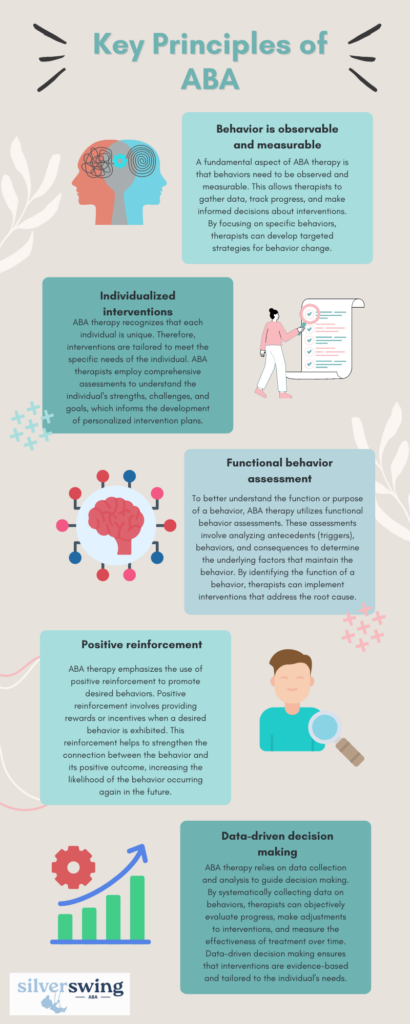To ensure success in applied behavior analysis (ABA) therapy, it is important to have a solid understanding of the foundational principles that guide this evidence-based approach. ABA therapy focuses on applying scientific principles to improve behaviors and enhance the lives of individuals. This section will provide an introduction to ABA therapy and explore the key principles that underpin its effectiveness.
Introduction to ABA Therapy
ABA therapy, or applied behavior analysis therapy, is a systematic and data-driven approach to understanding behavior and learning. It is widely recognized as an effective treatment for individuals with autism spectrum disorder (ASD). However, ABA principles can also be applied to various other populations and settings.
At its core, ABA therapy seeks to identify the factors that contribute to behaviors and develop strategies to modify or improve those behaviors. ABA therapists work closely with individuals to assess their behavior patterns, set goals, and implement interventions to bring about positive changes.
Key Principles of ABA
The principles of ABA are grounded in scientific research and have been refined over several decades. These principles provide the framework for understanding and modifying behavior. Some key principles include:

By understanding these key principles of ABA therapy, parents, caregivers, and ABA professionals can gain insight into the science-backed strategies used to improve behaviors and enhance the lives of individuals. As we continue to explore the dimensions and applications of ABA therapy, these principles will serve as a foundation for effective interventions.
The Dimensions of ABA
ABA therapy is based on scientific research and employs a systematic approach to encourage behavior changes and improve daily living for individuals, especially children, with autism. In this section, we will explore the seven dimensions of ABA therapy and the important role of a Board Certified Behavior Analyst (BCBA).
Seven Dimensions of ABA Therapy
ABA therapy encompasses seven dimensions that guide its implementation and ensure its effectiveness. These dimensions are rooted in scientific research and form the foundation of ABA principles. They are as follows:
- Applied: ABA focuses on socially significant behaviors that have practical importance in individuals’ lives. It aims to address behaviors that will enhance their daily functioning and overall well-being. By targeting behaviors that have a meaningful impact, ABA promotes positive changes in individuals’ lives.
- Behavioral: ABA is concerned with observable and measurable behaviors. It emphasizes the importance of clearly defining and objectively measuring behaviors to track progress accurately. This allows for data collection and analysis, facilitating evidence-based decision-making.
- Analytic: ABA relies on data collection and analysis to determine the effectiveness of interventions. By systematically collecting data, patterns and trends can be identified, enabling behavior analysts to make informed decisions about intervention strategies.
- Technological: ABA interventions are described in detail, allowing them to be replicated and implemented consistently. The use of clear and specific language ensures that interventions can be understood and implemented by different professionals, promoting treatment fidelity.
- Conceptually Systematic: ABA is grounded in behavioral principles and theories. It takes into account the existing body of scientific knowledge about behavior and learning. This systematic foundation ensures that ABA interventions are consistent with the principles of behavior analysis.
- Effective: ABA interventions are designed to produce meaningful and positive behavior changes. The effectiveness of interventions is continuously evaluated through data analysis. This evidence-based approach ensures that interventions are tailored to the individual’s needs and produce desirable outcomes.
- Generality: ABA interventions aim to promote generalization, meaning that the behavior changes extend beyond the therapy setting to other relevant environments. This includes transferring skills learned in therapy to everyday life situations, ensuring that the individual can independently apply the acquired skills.
The Role of a BCBA
A Board Certified Behavior Analyst (BCBA) plays a crucial role in ABA therapy. A BCBA is a highly trained professional who specializes in behavior analysis. They possess expertise in assessing, analyzing, and providing interventions to address behavioral issues and promote positive behavior changes.
BCBAs conduct assessments to understand an individual’s behavior and develop comprehensive behavior intervention plans. They collaborate with families, caregivers, and other professionals to design and implement effective interventions that target specific behaviors. BCBAs also monitor progress, collect and analyze data, and make data-driven decisions to modify and refine intervention strategies as needed.
The expertise of a BCBA is instrumental in ensuring that ABA therapy is customized to meet the unique needs of each individual. By applying scientifically-backed ABA principles, BCBAs play a vital role in improving behaviors at home and in social settings.
With the understanding of the seven dimensions of ABA therapy and the role of a BCBA, we can explore how ABA principles are applied in the collection and analysis of data, as well as in the strategies for behavior acquisition and generalization in the subsequent sections.

Applying ABA Principles
Once you have a foundational understanding of ABA therapy and its key principles, it’s time to explore how these principles are applied in practice. This section will delve into two important aspects of applying ABA principles: collecting and analyzing data, and understanding the basic principles of behavior.
Collecting and Analyzing Data
Data collection is a fundamental component of ABA therapy. It involves systematically recording and analyzing information about a person’s behavior. The data collected provides valuable insights into the individual’s patterns, progress, and areas that need attention.
To collect data effectively, ABA professionals use various methods such as direct observation, interviews, and questionnaires. By gathering this information, they can identify the antecedents (events that occur before a behavior) and consequences (events that occur after a behavior) that influence the target behavior. This data-driven approach allows for a better understanding of the function and context of the behavior.
Analyzing the collected data is equally important. ABA professionals use different techniques to analyze the data, such as visual analysis, trend lines, and statistical measures. Analyzing the data helps in identifying patterns, trends, and changes in behavior over time. This information guides the development of effective interventions and allows for ongoing assessment and adjustment of the treatment plan.

Basic Principles of Behavior
Understanding the basic principles of behavior is crucial for implementing effective ABA interventions. ABA professionals rely on these principles to design behavior change strategies and promote positive behavior.
One key principle of behavior is reinforcement. Reinforcement involves providing consequences that increase the likelihood of a behavior occurring again in the future. Positive reinforcement involves providing rewards or preferred items when the desired behavior is displayed, while negative reinforcement involves removing aversive stimuli when the desired behavior is exhibited. Both forms of reinforcement can be used strategically to reinforce desired behaviors in individuals.
Another important principle is punishment. Punishment involves providing consequences that decrease the likelihood of a behavior occurring again. It is important to note that punishment should be used sparingly and carefully, as its effectiveness depends on several factors such as the timing, intensity, and consistency of the punishment.
Extinction is another principle that involves the removal of reinforcement for a behavior, leading to a decrease in the occurrence of that behavior over time. Extinction is often used when dealing with behaviors that are maintained by attention or other forms of reinforcement.
By understanding and applying these basic principles of behavior, ABA professionals can develop tailored interventions to address challenging behaviors and promote the acquisition of more functional and appropriate behaviors over time.

Generalization of ABA Interventions
ABA therapy is designed to improve behaviors not only within specific settings but also in different environments and situations. The generalization of ABA interventions is a crucial aspect of ensuring that the skills and behaviors learned during therapy are transferred and maintained in daily life.
Extending Behavior Change to Different Settings
Extending behavior change to different settings means that the skills and behaviors learned in one environment can be applied and generalized to other settings. For example, if a child learns appropriate social skills during ABA therapy sessions, it is important for them to be able to use those skills in various social situations, such as at school, at home, and in the community.
ABA professionals work closely with individuals and their families to develop strategies that promote the generalization of behaviors. This may involve gradually introducing the individual to different settings and situations that resemble real-life scenarios where the targeted behaviors are expected. By systematically exposing the individual to these settings, ABA therapy aims to ensure that the behaviors learned are not limited to the therapy environment but can be used effectively in the individual’s day-to-day life.

Benefits of Starting ABA Early
Research and studies have consistently shown that beginning ABA therapy before the age of four can have a profound impact on a child’s development. Early intervention allows for targeted interventions and specialized treatment plans that can address specific challenges and behaviors at a critical stage of development.
By starting ABA therapy early, children have the opportunity to learn and acquire essential skills, such as social and communication skills, that are crucial for their overall development. ABA therapy focuses on teaching individuals the skills they need to navigate social interactions, communicate effectively, and engage in appropriate behaviors.
Moreover, early ABA intervention can help children with autism spectrum disorder (ASD) develop the necessary skills to interact and engage with their peers. It can improve their ability to understand and interpret social cues, leading to more successful social interactions and increased participation in various settings.
Enhancing Development in Children
One of the primary goals of ABA therapy is to enhance the overall development of children. Through the application of scientifically-backed ABA principles, therapists work to alter challenging behaviors and replace them with more functional and appropriate behaviors over time.
ABA therapy employs various techniques and strategies tailored to meet the unique needs of each child. These strategies may include discrete trial training, naturalistic teaching, and the use of visual supports and social stories. By utilizing evidence-based practices, ABA therapy aims to promote skill acquisition, reduce problem behaviors, and foster independence.
Early ABA intervention provides children with a solid foundation for future learning and development. It equips them with the necessary strategies and tools to navigate social situations, communicate more effectively, and adapt to different environments. As a result, children who receive early ABA intervention often demonstrate significant improvements in their overall functioning and quality of life.




